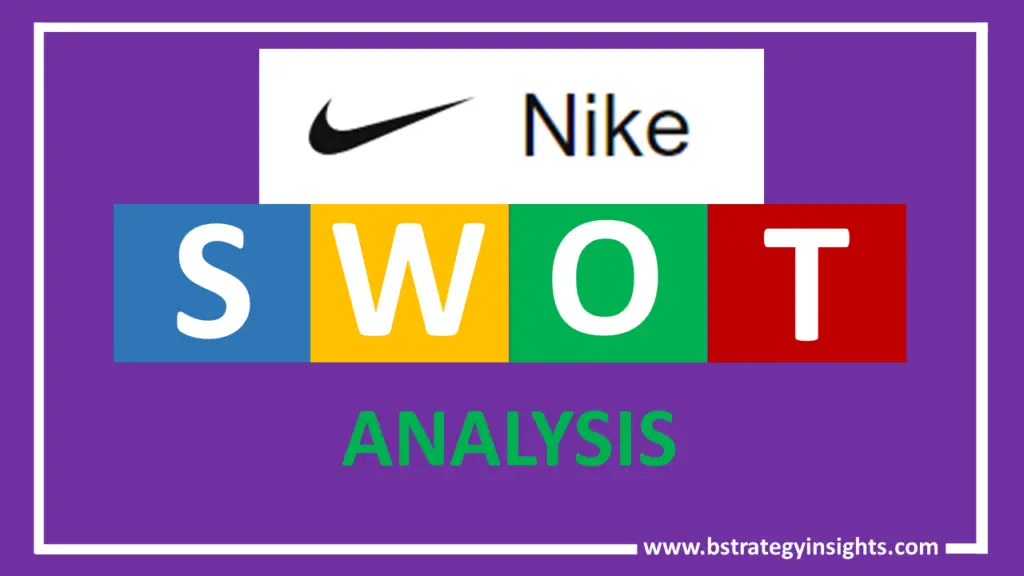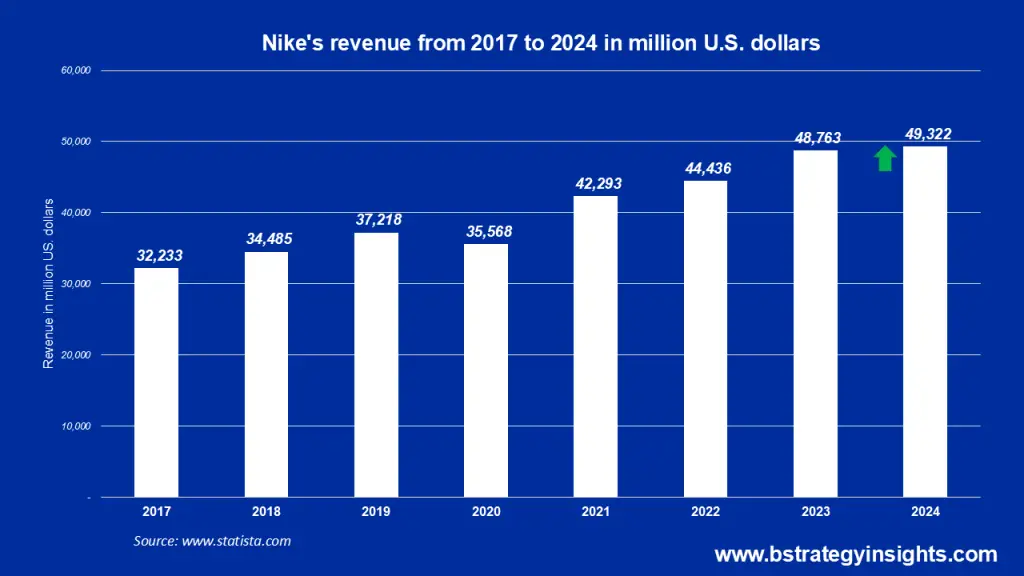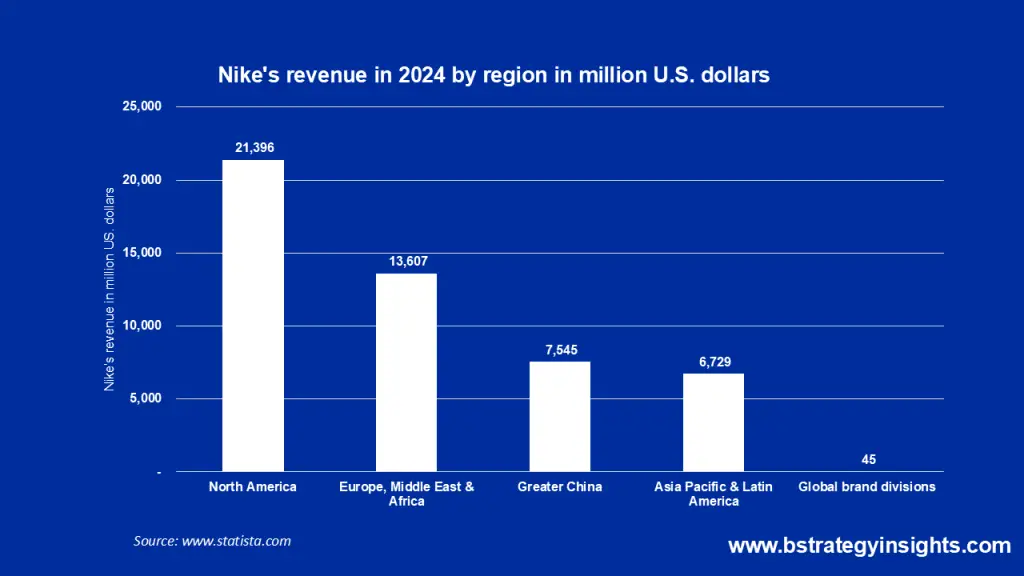
Nike is an American multinational company that was founded in 1964 by Bill Bowerman and Phil Knight. The brand specializes in athletic wear, such as shoes, apparel, accessories, and athletic equipment. Its major aim is to aid athletes in better sports performance. In this regard, the brand has registered massive success, so much so that it has ventured into athleisure wear, a niche that has really fast growth. This article takes a look at Nike’s SWOT analysis.
A SWOT analysis is a tool used to evaluate the strengths, weaknesses, opportunities, and threats of a company. Here is a potential SWOT analysis for Nike.
Nike – At a Glance
| Name | Nike |
| Website | https://www.nike.com |
| Founders | Joe Coulombe |
| Chief Executive Officer (C.E.O.) | Dan Bane |
| Headquarters | Monrovia, California, United States |
| Year Founded | 1967 |
| Type of company | Private |
| Revenues (FY 2024) | $49.32 Billion |
| Key Products/Services | Face & Body Care, Nutritional Supplements, Pet Stuff, Household Essentials, Flowers & Plants, Beverages, Food |
| Key Competitors | Kroger, Aldi, Costco, Target, Walmart, Publix, Safeway, HEB, Weis Markets, Raley’s, Giant Eagle, Meijer, Sprout’s Farmers, Fairway Market |
Nike’s global revenue has grown to 49,322 million U.S. dollars in 2024 represents an increase of 559 million U.S. dollars from 2023. This indicates that Nike’s revenue growth remains strong. Below chart summary the global revenue of Nike from 2017 to 2024. Based on this chart, it indicates that Nike’s revenue show a steady grow from year to year.

Nike’s Strengths
Strong brand recognition and equity
Nike is a well-known and respected brand in the athletic and fashion industries, with a strong following and loyal customer base. In 2021, Brand Finance ranked Nike as the most valuable apparel brand globally. For the 7th year in a row, Nike has been ranked the world’s most valuable sports brand. It has a strong presence on social media and other digital platforms. According to Brand Finance, although the brand value of Nike down by 6% to 31.3 billion in 2023, it still retains its tittle as the world most valuable apparel brand.
Strong brand loyalty and a huge customer base
Nike has an incredibly effective loyalty program with a huge customer attraction and retention strategy. The brand is ranked 9th globally for customer loyalty. This is strongly attributed to the brand’s Omnichannel loyalty system that makes use of apps among other system enables. As a result of this huge customer base, the brand’s market cap is $113.74 billion in 2025 (according to companiesmarketcap.com).
Diverse product offerings
Nike offers a wide range of products, including athletic shoes, apparel, and equipment for a variety of sports and activities. This diversity allows Nike to appeal to a wide range of customers, from professional athletes to casual fitness enthusiasts.
Innovation and technology
Nike is known for its innovative products and use of technology, such as its use of Flywire in its footwear and its Nike+ platform for tracking fitness activities. The company invests heavily in research and development, which allows it to stay at the forefront of industry trends and introduce new, high-tech products.
Strong partnerships and collaborations
Nike has partnerships and collaborations with many major athletes, teams, and events, which helps to increase its visibility and credibility. These partnerships also provide Nike with valuable insights into the needs and preferences of its target audience. For instance, Nike has had a strong relationship with Michael Jordan that has resulted in impressive revenues from Air Jordan 1 Shoes.
Decentralized manufacturing
A majority of Nike’s footwear is manufactured in foreign countries. For instance, in 2021, 51% of the brand’s footwear was manufactured in Vietnam, China produced 24%, and 21% of production was done in Indonesia. Other areas of manufacturing include Brazil, Argentina, Italy, Mexico, and India. This decentralization offers the brand the advantage of the low cost of production. Additionally, decentralization lowers the risk of a single point of failure.
In the event of an adverse occurrence like a fire or an earthquake affecting one location, the brand’s operations would continue with production from the other manufacturing plants. This would not be the case if the brand had only one manufacturing plant, which was hit by an earthquake.
Nike’s Weaknesses
Dependence on key suppliers
Nike relies on a small number of key suppliers for its products, which can make it vulnerable to supply chain disruptions. For example, if a key supplier experiences a production issue or natural disaster, it could have a significant impact on Nike’s ability to meet customer demand.
High cost of product development
Nike invests heavily in research and development, which can be expensive and may not always result in successful products. This investment is necessary to stay competitive in the market, but it also exposes Nike to the risk of financial losses if a new product does not meet expectations.
Intellectual property disputes
Nike has faced intellectual property disputes in the past, which can be costly and time-consuming to resolve. These disputes can arise due to issues such as trademark infringement or patent violations, and they can damage the company’s reputation and financial performance.
Nike’s Opportunities
Growing demand for athletic and fitness products
As more people become interested in health and wellness, there is an opportunity for Nike to increase sales of its athletic and fitness products. This trend is particularly evident in emerging markets, where the middle class is expanding, and people are more able to afford premium athletic products.
Expanding into new markets
Nike has the opportunity to expand into new markets, both domestically and internationally, to reach new customers and increase revenue. For example, Nike could consider expanding its markets in Asia or Latin America, where the demand for athletic and fitness products is growing. Below chart show Nike’s revenue by region in 2024.

Increasing online sales
Nike can continue to focus on expanding its online presence and improving its e-commerce capabilities to reach more customers and increase sales. The online retail market is growing rapidly, and Nike has a strong brand presence in this space. By leveraging its online platforms and partnerships, Nike can increase its reach and sales without the need to invest in physical storefronts.
Nike’s Threats
Intense competition
Nike faces intense competition from other athletic and fashion brands, both domestic and international. These brands are constantly introducing new products and marketing campaigns, which can make it difficult for Nike to maintain its market share.
Changes in consumer preferences
Nike’s products and marketing strategies need to stay current and appeal to changing consumer preferences in order.
Conclusion
Nike is a huge brand in sportswear with impressive revenues and a huge customer base to support the brand. The brand, however, faces intense competition from other multinationals. The brand would need to continuously innovate and market its products. The brand needs more research to keep up with the changing needs and preferences of customers.


